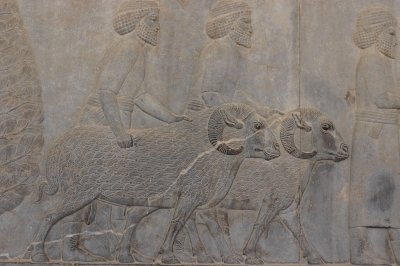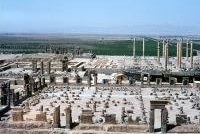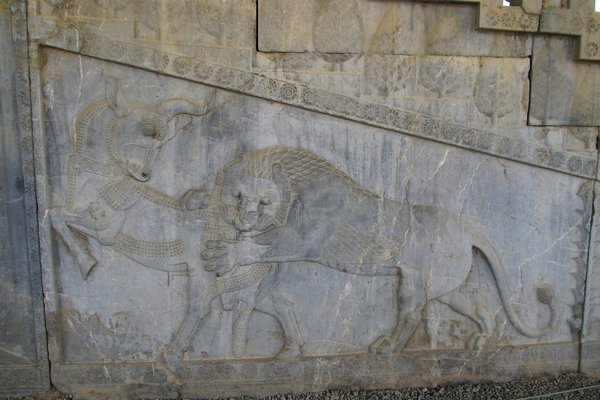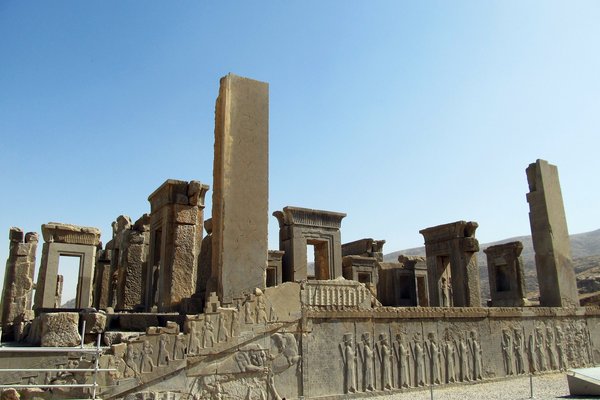Iran
Persepolis
Persepolis was the ancient ceremonial capital of the second Iranian dynasty, the Achaemenid Empire.
The earliest remains of Persepolis date from around 518 BCE. It was Darius the Great who built the monumental terrace, stairways, and the great palaces in this royal city. They are decorated with sculpted friezes and columns.
Community Perspective: The site is particularly famous for its bas reliefs, which are in superb condition and 'in situ'. "If I could give it 6 stars I would do it", one of the reviewers stated.
Site Info
Official Information
- Full Name
- Persepolis (ID: 114)
- Country
- Iran
- Status
-
Inscribed 1979
Site history
History of Persepolis
- 1979: Inscribed
- Inscribed
- Type
- Cultural
- Criteria
- i
- iii
- vi
Links
- UNESCO
- whc.unesco.org
- Official
-
- persepolis.info — Info on Persepolis
- Related
-
- visitiran.ir — Visit Iran
All Links
UNESCO.org
- whc.unesco.org — whc.unesco.org/
Official Website
- persepolis.info — Info on Persepolis
Related Resources
- visitiran.ir — Visit Iran
News Article
- Dec. 26, 2024 tehrantimes.com — Iran plans new tourist pathway linking Persepolis, Naqsh-e Rostam, and Naqsh-e Rajab
- Sept. 1, 2024 tehrantimes.com — Moisture threatens rock-hewn tomb of Artaxerxes III in Persepolis
- March 19, 2024 tehrantimes.com — UNESCO-listed Persepolis to showcase ancient waterways
- Feb. 22, 2017 financialtribune.com — Italian, Spanish Experts to Help Rid Persepolis of Lichens
- Dec. 31, 2016 financialtribune.com — Japan to Help Restore Persepolis
- June 13, 2012 payvand.com — Part of Persepolis sewage system unearthed
- June 7, 2009 adnkronos.com — Italian archeologists find commoner's neighborhoods in Persepolis
- May 27, 2007 chnpress.com — Iran in conjunction with UNESCO has called an international cooperation for cleaning up the lichen from body of Persepolis World Heritage Site.
- April 22, 2007 rferl.org — Around 100 Iranians demonstrated in Tehran today against a dam project that critics say will likely flood the country's grandest archeological sites.Protesters carried banners and symbols from Iran's pre-Islamic Zoroastrian religion and called for the resignation of the top culture and heritage official.
- March 12, 2007 chnpress.com — Black stains left recently by a film crew on the walls of the palace of Achaemenid Emperor Darius the Great in Persepolis were removed successfully.
- Nov. 14, 2006 mehrnews.ir — Railroad leading Persepolis to List of World Heritage in Danger
Community Information
- Community Category
- Archaeological site: Near Eastern
Travel Information
Red Zone Travel Advisory
Iran fully off-limits
Shiraz Hotspot
Recent Connections
-
No Map
-
Famous Love Stories
Ahaseurus and Esther
-
Red Zone Travel Advisory
Iran fully off-limits
Connections of Persepolis
- Individual People
-
-
Alexander the Great
The complex was taken by the army of Alexander the Great in 330 BC, and soon after the wooden parts were completely destroyed by fire (wiki)See www.ancient.eu
-
Henry Morton Stanley
Inscribed his name as Graffiti on Bull Gates "Stanley New York Herald 1870". Still visible! -
Mohammad Reza Shah Pahlavi
Location in 1971 for the extravagant celebration of 2500 years of the Persian Empire since Cyrus the Great. "The intent of the celebration was to demonstrate Iran's long history and to showcase its contemporary advancements under Mohammad Reza Pahlevi, the Shah of Iran." Wiki - seeSee en.wikipedia.org
-
Giosafat Barbaro
Barbaro visited the ruins of Persepolis, which he incorrectly thought were of Jewish origin. -
Odoric of Pordenone
"He seems to have wandered through Persia and Mesopotamia, visiting Kashan, Yazd, Persepolis, and Baghdad." (wiki)
-
- Trivia
-
-
In the Pergamon museum
Numerous reliefs -
Famous Love Stories
Ahaseurus and Esther
-
In Video Games
Civilization VI: Apadana; Civilization VII: Gate of All Nations -
In the Louvre
Man carrying a kid goatSee www.louvre.fr
-
In the British museum
Room 52 with some reliefs
-
- History
-
-
Eunuchs
-
Located in a Former Capital
Achaemenid Empire - Cyrus -
Achaemenid Empire
Persepolis was the ceremonial capital of the Achaemenid Empire. André Godard, the French archaeologist who excavated Persepolis in the early 1930s, believed that it was Cyrus the Great who chose the site of Persepolis, but that it was Darius I who built the terrace and the palaces. Inscriptions on these buildings support the belief that they were constructed by Darius.See en.wikipedia.org
-
- Architecture
-
-
Hypostyle
"As a word, "apadāna" (Old Persian) is used to designate a hypostyle hall," (Wiki) The Apadana Palace at Perspolis is such a structure -See en.wikipedia.org
-
- Damaged
-
-
Destroyed during invasion
Alexander the Great 330BC
-
- World Heritage Process
-
-
Perfect Inscriptions
1979 -
Extensions on Tentative List
Sacred mount of Mehr, Royal mausoleums in Naghsh-e Rajab and the city of Estakhr -
No Map
-
- Religion and Belief
-
-
Griffins
Double-headed griffinSee aksonline.ir
-
Zoroastrianism
Host of the ancient Zoroastrian festival, Norouz
-
- Human Activity
-
-
Historical Graffiti
Over the years, many travelers left their mark on the ruins in the form of graffiti, including ... Henry Morton Stanley. The foreign graffiti are concentrated in two particular spots, namely Xerxes’ Gate of All Nations and the Palace of Darius. -
Man-made Terraces
Persepolis is located over a half artificial terrace.
-
- Constructions
-
-
Protective Shelters
The Apadana Staircase has been protected by a roof since the mid 1990s
-
- Timeline
-
-
Built in the 6th century BC
Founded in 518 BC
-
- WHS Hotspots
-
-
Shiraz Hotspot
1hr one way by car
-
- Science and Technology
-
-
University of Chicago Oriental Institute
The OI was in possesion of the "Achaemenid Tablets" from c500BC on loan from Iran since 1937 with the understanding that they would be returned - indeed some had been (They had been discovered by OI archaeologists during excavations at Persepolis in 1933). In 2006 Federal courts ruled that the tablets should be sold and the proceeds used to compensate victims of the Ben Yehuda St bombing of 1997 in Jerusalem which the US claimed had been funded by Iran. A group of vicitms had won a $71 million judgment against Iran in 2003. OI has opposed the seizure - the matter is still unresolved -
Excavated by American Universities
University of Chicago
-
- Visiting conditions
-
-
Foreigner prices
30,000 Rials versus 200,000 RialsSee persepolis.info
-
Red Zone Travel Advisory
Iran fully off-limits
-
News
- tehrantimes.com 12/26/2024
- Iran plans new tourist pathway lin…
- tehrantimes.com 09/01/2024
- Moisture threatens rock-hewn tomb …
- tehrantimes.com 03/19/2024
- UNESCO-listed Persepolis to showca…
Recent Visitors
Visitors of Persepolis
- AC
- Adrian Turtschi
- Afshin Iranpour
- Alexander Barabanov
- Alexander Lehmann
- Alexander Parsons
- Ali Zingstra
- A. Mehmet Haksever
- Ammon Watkins
- Artur Anuszewski
- Ask Gudmundsen
- Aspasia
- Atila Ege
- AYB
- Bamse
- BaziFettehenne
- Bernard Joseph Esposo Guerrero
- Bill Maurmann
- Bram de Bruin
- Carlo Sarion
- Chalamphol Therakul
- Chantal den Haan
- Christian Wagner
- Cirene Moraes
- David Marton
- Dimitrios Polychronopoulos
- DouglasR
- Emili Xaus
- Eric Lurio
- Erik Jelinek
- Eva Kisgyorgy
- Fan Yibo
- Fernweh
- Fmaiolo@yahoo.com
- George Gdanski
- Hammeel
- Harald T.
- Harry Mitsidis
- Iain Jackson
- Ivan Rucek
- Jacob Otten
- janis
- Janos
- Jarek Pokrzywnicki
- Javier
- Jean Lecaillon
- Jonas Kremer
- Jon Opol
- Joyce van Soest
- Juha Sjoeblom
- jxrocky
- Ken DJ
- Kevin247
- kiank37
- Knut
- Krijn
- LaVale
- Loic Pedras
- Luis Filipe Gaspar
- Maciej Gil
- Malgorzata Kopczynska
- marcel staron
- Marcobrey
- Martin
- Martina Rúčková
- Marton Kemeny
- MaYumin
- Mikko
- Milan Jirasek
- Miloš Tašković
- MoPython
- Morodhi
- Naim Y
- Niall Sclater
- Nihal Ege
- opperpco3
- Palimpsesto
- Patrik_globe
- petar
- Philipp Leu
- Pieter Dijkshoorn
- qwertzlbry
- Reisedachs
- Rodinia
- Roger Ourset
- Roman Bruehwiler
- Sergio Arjona
- Solivagant
- Ssong.x
- Stanislaw Warwas
- Szucs Tamas
- Taotao Chen
- Tarquinio_Superbo
- Thomas Buechler
- Timothy C Easton
- Tinamu
- Tony H.
- triath
- Westwards
- Wieland
- Wojciech Fedoruk
- Wo_ko
- Xander Huang
- Yongcheng Liu
- Zizmondka
- Zoë Sheng
Community Reviews
Show full reviews
If I could give it 6 stars I would do it. The level of craftsmanship shown in the delegations at Apadana for me is simply mindblowing. I visited Angkor several months after Persepolis and looking at the Khmer details, I felt slightly disappointed (I know that limestone and sandstone are not the same, but still). It takes a good guide (and not a lot of people around) to point out the intricacies of the delegations (ribbons on shoelaces, fingers bent while carrying vessels, various headgears). I am still in awe even now, 2 years after.
Keep reading 0 comments
The pre-Islamic heritage of the middle east and central Asia hasn't always been as appreciated by Moslems as it is now, note the notorious destruction of the Giant Buddha's in Bamiya, Afghanistan back in March of 2001, or the sale of the Elgin marbles, and all that ancient Egyptian art in various museums around the world. It was something like that which almost happened in Persepolis back during the dark days of the hostage crisis when the limits of revolution were reached. As to the details of the incident below, I cannot vouch for the details, and I never found out the names of the people involved, all I know is that a second tour guide acknowledged the event took place. (Any more information on the subject would be appreciated.)
According to Islamic lore, in the year 610 of the Christian Era, a certain Abu l-Qasim Muhammad ibn ‘Abd Allâh al-Hashimi al-Qurashi was ordered by the Archangel Jabril to read out loud from a book that didn't yet exist. Prior to that, the world was in the "age of ignorance" and what was produced didn't matter all that much.
For the next 1,189 years, most of what was built by the hands of man prior to that was either ignored or destroyed. True, the works of certain Greek and Jewish philosophers were preserved and studied. Euclid and Galen were very useful, after all, but what was left of the great library at Alexandria was burned to the ground (although some …
Keep reading 0 comments
One of my lifetime “travel objectives” has been to visit at least 1 archaeological site from every “significant” (Yes I know this is judgemental but you can’t grind too small!) civilization/empire in world history. For all its fame and extent (from the Indus to Egypt) the Persian Empire has remarkably few extant remains. As far as I know, all are within the boundaries of modern Iran and only 2 (Persepolis and Pasargadae) are WHS (3 other significant sites are at Bisitun, Susa/Shoush and Naqsh-I-Rustam - all of which are on Iran’s Tentative List). This lack of “extended remains” is perhaps because the Empire’s “period of greatness” was remarkably short – from the fall of the Babylonians around 539 BCE to the defeat by Alexander in 331 BCE – i.e. only just over 2 centuries and within that time they fitted in Cyrus, Darius, Xerxes and several others! Also because the Empire was run from the heartland with the outlying provinces or “Satrapies” run semi-autonomously.
While I would like to visit the other sites I have at least achieved my ambition for this Empire by visiting Persepolis and can recommend it. However I still have to visit sites for 2 other civilisations from that area :-
a The Elamites - who preceded Babylon, and have a WHS at Tchoga Zambil in Iran
b. The Medes – who in the Bible (Daniel) were always linked with the Persians (“The Medes and the Persians…”) Their “empire” just preceded that of the Persians until …
Keep reading 0 comments

